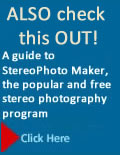
Filling orders for stereocards at the Kilburn factory.

The stereocard revolution was world-wide. Here a stereo card shows some boys in Japan using a stereo viewer.

The Brewster viewer was heavy and expensive.

Although most stereo cards were the standard 3.5 x 7 inch size (bottom), there were also imperial 4 x 7 inch cards (top) and occasionally cards with other heights—but almost always the same width so they would fit in the viewers.
In what seems like an amazing coincidence, Charles Wheatstone announced his discovery of the principles of stereoscopic vision in 1838, and only 6 months later Henry Fox Talbot and Louis Daguerre announced their respective discoveries of photography. Ever since, people have been combining the two. In fact, some of the first stereo photos were taken by Henry Fox Talbot, the inventor of the positive/negative approach to photography.
3D or stereoscopic photography uses two images of a scene taken from slightly different viewpoints—called a stereo pair.

Two camera lenses about 2.5 inches (6.5 cm) apart see the same row of blocks from slightly different angles due to parallax. Here the effect is exaggerated to make it more obvious.
At a quick glance the images in a stereo pair look identical but have small differences. When viewed side-by-side, with the left eye seeing only the left image and the right eye only the right. The two 2D images are combined in your mind into a single 3D image, a process called fusion, and the small differences in the images produce the illusion of depth.

A hand colored stereoscopic daguerreotype of Fanny and John Stevenson taken between 1850 and 1860. Courtesy of the Library of Congress Prints and Photographs Division Washington, D.C. 20540 USA.

A stereo card showing Charles Wheatstone and his family, taken by Antoine Claudet (died 1867), and given to the National Portrait Gallery, London in 1980.
Once stereo photos started to circulate and grow in popularity, efforts began in earnest to develop a viewer that would make viewing them more convenient and less expensive. One of the first such viewers was invented by David Brewster, who exclaimed enthusiastically after seeing the results "No portrait ever painted, and no statue ever carved, approximates in the slightest to the living reality now before us." The most popular viewer was designed by Boston's Oliver
Wendall Holmes—called the Holmes stereoscope. Once these inexpensive, easy to use viewers were widely available, views of foreign places, interesting people and events, and other scenes of all kinds, became the rage in Victorian homes. In an era when travel was slow and difficult, stereo cards opened an inexpensive window onto the world. Millions of these cards were sold in stores, by catalog, and even by door to door salesmen. You can find some of these cards on eBay and in almost any antique shop. Some, like those taken by famous photographers or showing scenes from historic events such as the Civil War, are very expensive and are rapidly disappearing as collectors gather them up. These mass—produced stereo cards (also called stereoviews, stereographs and stereoscopic photographs) have two prints mounted side-by-side on a 7 x 3.5 inch piece of cardboard. To see the 3D effect you insert the card into a Holmes viewer and view it through a pair of eyepieces. For almost a century people would gather in the parlor and pass a viewer around—exclaiming and discussing each stereo photo as it circulated.

The light and inexpensive Holmes stereoscope made viewing stereo cards a major Victorian past time.

A Victorian era woman using a Holmes stereoscope. Courtesy of the Library of Congress Prints and Photographs Division.

The tabletop Charles Wheatstone reflecting stereoscope used mirrors to view two large images from a stereo pair.

